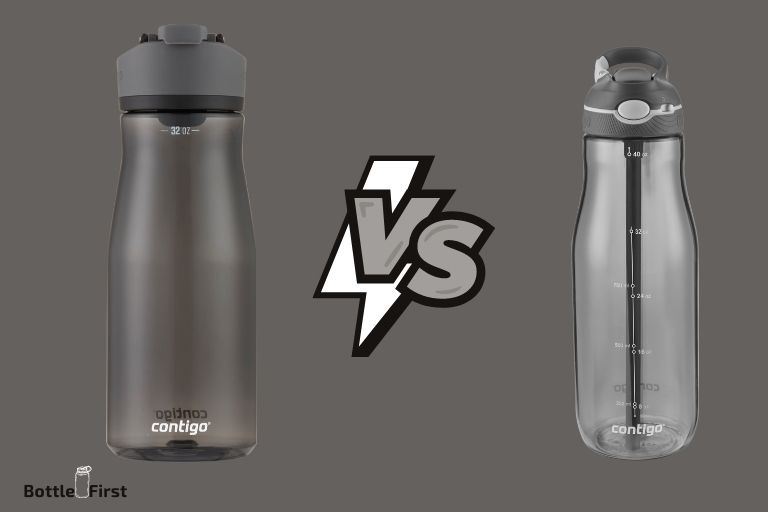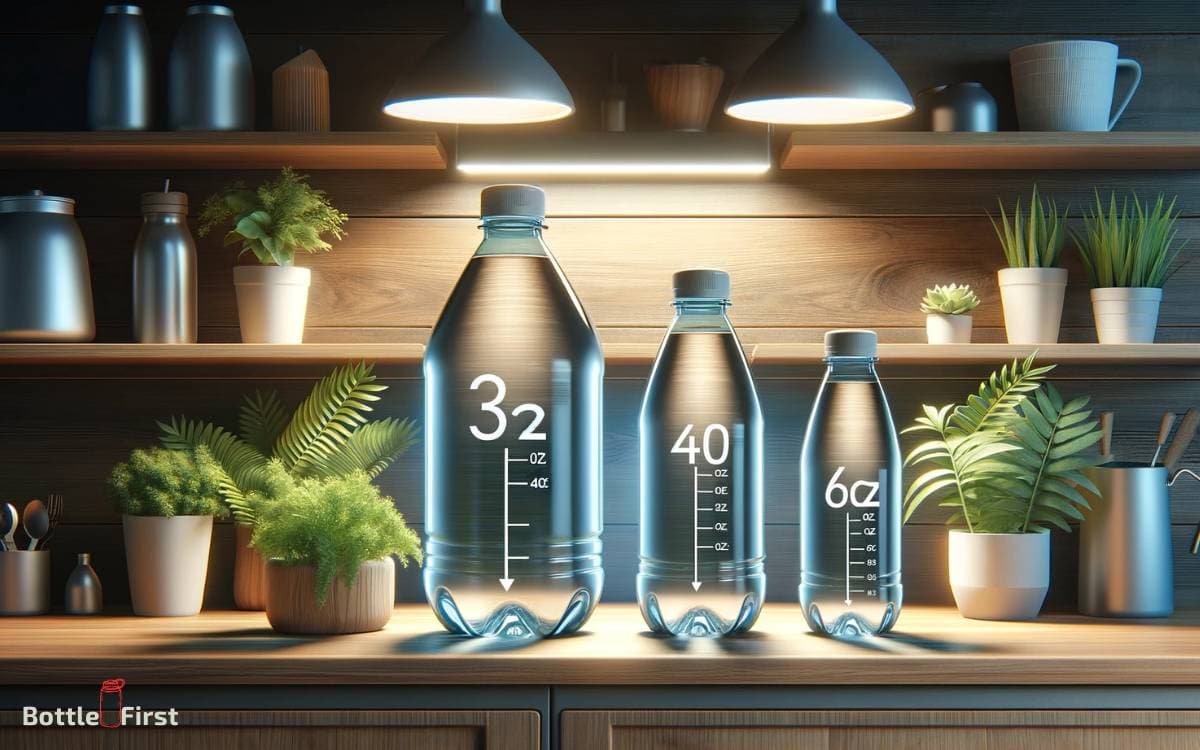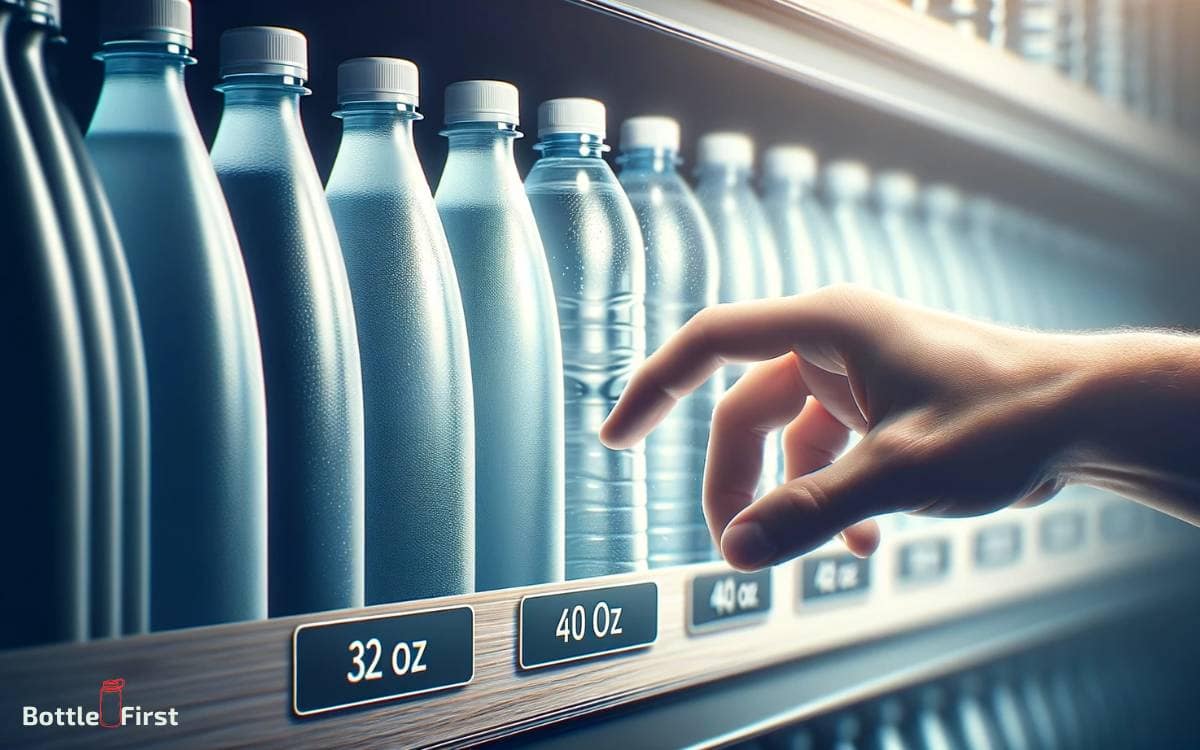32 Oz Vs 40 Oz Water Bottle: Which one Better!
A 32 oz water bottle holds 32 fluid ounces of water, which is equivalent to 4 cups or 1 quart, while a 40 oz water bottle holds 40 fluid ounces of water, which is equivalent to 5 cups or 1.25 quarts.
The difference between a 32 oz and a 40 oz water bottle is the amount of water that they can carry. The 32 oz water bottle is generally smaller and more portable than the 40 oz water bottle.
However, the 40 oz water bottle can hold more water which can be advantageous for long trips or for individuals who consume a large amount of water daily.
Choosing between a 32 oz and a 40 oz water bottle ultimately depends on your needs and lifestyle. If you are always on the go and prefer something light and easy to carry around, then a 32 oz bottle might be more suitable.
However, if you are an athlete, work out regularly, or simply prefer not to refill your bottle frequently, then a 40 oz bottle might be the better option.
Key Takeaway
Comparing the Size of 32 Oz and 40 Oz Water Bottles
| Features | 32 Oz Water Bottle | 40 Oz Water Bottle |
|---|---|---|
| Capacity | 32 Oz (946 ml) | 40 Oz (1182 ml) |
| Ideal For | Short outdoor activities, office use, short commutes | Long hikes, intense workouts, long trips |
| Refills Needed (For 8 cups of water intake) | 2 times approximately | 1.5 times approximately |
| Weight (When Full) | Lighter | Heavier |
| Space Required | Less | More |
| Hydration Level | Moderate | High |
| Price Range | Generally cheaper | Generally more expensive |
Understanding The Importance Of Proper Hydration
The Role Of Water In Staying Healthy And Active
Proper hydration is essential for maintaining overall health and staying active. Water plays a crucial role in various bodily functions, and its benefits cannot be overstated.
In this section, we will explore the importance of water in keeping your body functioning optimally.
Key Points:
- Hydration for energy: Drinking an adequate amount of water is vital for maintaining energy levels throughout the day. Dehydration can lead to fatigue and decreased physical and mental performance. By staying properly hydrated, you can optimize your energy levels and remain active and alert.
- Temperature regulation: Water helps regulate body temperature through sweating and evaporation. Adequate hydration is especially important during warmer months or when engaging in physical activities that cause excessive sweating. By drinking enough water, you can prevent overheating and dehydration.
- Nutrient transport: Water aids in the transportation of nutrients throughout the body. It helps deliver essential vitamins, minerals, and oxygen to cells, allowing them to function efficiently. Without proper hydration, this process is hindered, potentially leading to nutrient imbalances and decreased overall health.
- Joint lubrication: Adequate water intake is crucial for maintaining healthy joints. Water acts as a lubricant, reducing friction between joints and ensuring smooth movement. Proper hydration can help alleviate joint pain and stiffness, allowing you to engage in physical activities comfortably.
- Waste removal: Water plays a significant role in the removal of waste products from the body. It helps flush out toxins, supports kidney function, and aids in digestion. Without sufficient hydration, waste can accumulate in the body, leading to various health issues. Stay hydrated to support proper waste elimination.
How Much Water Should You Be Drinking Per Day?
Knowing the recommended daily water intake is crucial for maintaining proper hydration. The ideal amount can vary depending on factors such as age, gender, activity level, and climate. Understanding your individual needs will help ensure you’re hydrating adequately.
Key Points:
- General guidelines: While individual requirements may differ, a commonly recommended guideline is to consume at least eight 8-ounce glasses of water per day, also known as the 8×8 rule. This equates to approximately 2 liters or half a gallon. However, this is a general guideline, and individual needs may vary.
- Factors to consider: Factors such as physical activity, climate, and overall health play a role in determining your personal hydration needs. Engaging in intense exercise or living in a hot and humid climate may require increased water intake to compensate for fluid loss.
- Listen to your body: Pay attention to your body’s cues for thirst and adjust your water intake accordingly. Thirst is an indication that your body needs hydration, so don’t ignore it. Additionally, the color of your urine can be an indicator of hydration levels. Clear or light yellow urine generally signifies proper hydration, while dark-colored urine may indicate dehydration.
- Individual needs: Consult with a healthcare professional to determine your specific hydration needs. Factors such as medical conditions, medications, and pregnancy can affect your water requirements. Seek personalized advice to ensure you’re staying adequately hydrated.
Remember, proper hydration is key to maintaining a healthy and active lifestyle.
By understanding the role water plays in your overall well-being and paying attention to your body’s signals, you can ensure you’re getting the right amount of water each day.
Stay hydrated and enjoy the numerous benefits it brings.
Choosing The Right Water Bottle Size For Your Needs
When it comes to staying hydrated throughout the day, having a reliable water bottle is essential. With so many options available, it’s important to choose the right size that suits your needs.
Whether you’re on-the-go, hitting the gym, or simply want to have water readily accessible, the decision between a 32 oz and a 40 oz water bottle can be a tough one.
To help you make an informed choice, here are some factors to consider:
Factors To Consider When Selecting A Water Bottle Size
- Daily water intake: Consider how much water you typically consume in a day. The recommended daily intake for adults is around 64 oz, so a 32 oz water bottle may be sufficient for those who prefer refilling their bottle multiple times. However, if you’re looking to consume your recommended intake in just a few refills, a 40 oz water bottle might be more suitable.
- Portability: Think about where you’ll be taking your water bottle. If you’re always on the move, whether it’s for work, travel, or outdoor activities, portability is key. A 32 oz water bottle tends to be more compact and easier to carry than a larger 40 oz one, making it convenient for those constantly on the go.
- Gym and sports activities: If you’re an avid gym-goer or participate in sports, you’ll want a water bottle that can quench your thirst during intense workouts. The larger size of a 40 oz water bottle means you won’t have to refill as frequently, ensuring you stay hydrated throughout your exercise routine.
- Durability: Consider the material and build quality of the water bottle. Thicker and sturdier bottles are less likely to break or leak, and this is especially important for larger sizes. If you’re prone to accidents or need a bottle that can withstand rough handling, a 40 oz water bottle may be a better choice.
The Benefits Of Larger Water Bottle Sizes
- Longer hydration periods: With a 40 oz water bottle, you can indulge in longer periods of hydration without the need for frequent refills. This is particularly advantageous during long hikes, road trips, or when you simply want to minimize interruptions throughout your day.
- Convenience for group settings: If you often find yourself sharing your water bottle with others, a larger size can accommodate multiple people without running out of water too quickly. Whether you’re camping with friends or attending outdoor events, a 40 oz water bottle can be a great companion.
- Motivation to drink more: Having a larger water bottle can serve as a visual reminder to drink more water throughout the day. The volume of a 40 oz bottle may encourage you to reach your hydration goals by keeping track of your water intake and staying consistent.
Choosing the right water bottle size ultimately depends on your lifestyle, daily water intake, and specific needs.
Whether you opt for a 32 oz or 40 oz water bottle, the most important factor is to ensure that you stay hydrated and prioritize your health.
So, go ahead, make your choice, and enjoy the benefits of a well-hydrated lifestyle!
Comparing The Features Of 32 Oz And 40 Oz Water Bottles
The choice between a 32 oz and 40 oz water bottle may seem like a small one, but it can make a big difference in your hydration routine. Both sizes have their pros and cons, depending on your needs and preferences.
Let’s explore the key features that set these two bottle sizes apart.
Design Differences And Materials Used:
- 32 oz water bottles are typically more compact and lighter, making them easier to carry in bags or backpacks.
- On the other hand, 40 oz water bottles are larger and may be bulkier, but they offer greater capacity for those who need to carry more water throughout the day.
- Both bottle sizes come in a variety of materials, including plastic, stainless steel, and glass.
- Plastic bottles are lightweight and durable, but they may not offer the same level of insulation as stainless steel or glass.
- Stainless steel bottles provide better insulation, keeping your water cold for longer periods. They are also more durable and resistant to breakage compared to plastic bottles.
- Glass bottles, although less common, offer a sleek and eco-friendly option. They do require extra care due to their fragility.
Portability And Ease Of Use:
- The smaller size of 32 oz water bottles makes them convenient for on-the-go use. They can easily fit into cup holders, backpack pockets, or bicycle holders.
- The larger size of 40 oz water bottles may be less convenient to carry around, especially during outdoor activities or while traveling. However, some brands offer features like handles or straps for easy transport.
Durability And Insulation Capabilities:
- When it comes to durability, both 32 oz and 40 oz water bottles are built to withstand everyday use. However, stainless steel bottles tend to be more resistant to dents and scratches compared to plastic or glass.
- In terms of insulation capabilities, stainless steel bottles excel at keeping your drinks cold or hot for extended periods. They are designed with double-wall vacuum insulation, preventing heat transfer between the contents and the external environment.
By considering these key features, you can now make an informed decision on whether a 32 oz or 40 oz water bottle is the right choice for you.
Whether you prioritize portability, capacity, durability, or insulation, there is a water bottle size and material that will suit your lifestyle and hydration needs.
Choose wisely and stay hydrated throughout your day!
Exploring The Practical Uses Of 32 Oz And 40 Oz Water Bottles
When it comes to staying hydrated, having a reliable water bottle by your side is essential. With so many options available, it can be overwhelming to choose the right size for your needs.
In this section, we will explore the practical uses of 32 oz and 40 oz water bottles, helping you determine which one is best suited for your lifestyle.
Everyday Hydration At Work, School, Or The Gym
- The 32 oz water bottle is a great choice for those who are constantly on the go and need a convenient option for everyday hydration.
- With its manageable size, it easily fits in most cup holders, backpack pockets, and gym bags.
- This size is ideal for those who prefer to sip throughout the day rather than guzzling large amounts of water at once.
Outdoor Activities And Adventures
- If you enjoy outdoor activities or embarking on adventures, the 40 oz water bottle may be more suitable for you.
- Its larger capacity ensures that you have enough water to keep you hydrated during extended periods of physical exertion.
- Whether you’re hiking, biking, or camping, the 40 oz water bottle will provide you with ample hydration without the need for frequent refills.
Traveling And Staying Hydrated On The Go
- For frequent travelers, having a reliable water bottle is crucial to stay hydrated while on the move.
- The 32 oz water bottle is a practical choice for travel, as it easily fits into most carry-on bags and backpacks.
- It is also a convenient size to navigate through airport security without any issues.
- On the other hand, the 40 oz water bottle may be a bit bulkier for travel purposes but can still be a viable option for longer trips where access to water may be limited.
The choice between a 32 oz and 40 oz water bottle ultimately depends on your specific needs and preferences.
Consider factors such as convenience, portability, and the duration of your activities when making your decision.
Whatever size you choose, making sure you stay hydrated is key to maintaining optimal health and well-being.
So grab your water bottle, fill it up, and make hydration a priority in your daily routine.
Making The Final Decision: Which Size Is Right For You?
Assessing Your Hydration Needs And Lifestyle
When it comes to choosing the right water bottle size, it’s important to assess your hydration needs and consider your lifestyle.
Here are some key points to keep in mind:
- Evaluate your daily water intake: Take a moment to think about how much water you typically drink in a day. Are you someone who sips water throughout the day or do you prefer to drink larger amounts at once? This will help you determine the appropriate size for your water bottle.
- Consider your activity level: If you lead an active lifestyle and engage in activities that make you sweat, you may need a larger water bottle to ensure you stay properly hydrated. On the other hand, if you have a more sedentary routine, a smaller bottle may be sufficient.
- Think about the duration of your outings: Are you someone who spends long hours outdoors or frequently travels? If so, a larger water bottle may be beneficial to ensure you have enough water to last throughout your adventures. Alternatively, if you mainly stay indoors or have access to hydration sources, a smaller bottle might be more practical.
Considering Personal Preferences And Habits
Your personal preferences and habits should also play a role in determining the right water bottle size for you.
Here are some factors to consider:
- Portability: If you’re constantly on the go and value portability, a smaller water bottle may be the ideal choice. It can easily fit into your bag or cup holder and won’t weigh you down.
- Ease of drinking: Do you prefer sipping water through a straw or drinking directly from the bottle? This can influence the size and shape of the water bottle you choose. Some larger bottles may come with built-in straws or spouts for convenient drinking.
- Refill frequency: How often are you willing to refill your water bottle? If you prefer fewer refills, a larger bottle will save you time and effort. However, if you enjoy having fresh, cold water more frequently, a smaller bottle may be more suitable.
Final Tips For Choosing The Perfect Water Bottle Size
To help you make the final decision, here are some additional tips to consider:
- Try it out: If you’re unsure about which size to go for, consider borrowing a friend’s or using a disposable water bottle of different sizes for a few days. This trial period will give you a better understanding of your preferences and needs.
- Consider the weight: Keep in mind that larger water bottles can be heavier, especially when filled to the brim. If weight is a concern for you, opt for a smaller bottle that you can easily carry around without strain.
- Think about other uses: Water bottles can serve multiple purposes beyond just hydration. If you plan to use your bottle for other beverages or even as a container for snacks, a larger size may be more versatile.
Remember, choosing the right water bottle size ultimately boils down to your individual needs, preferences, and lifestyle. Take the time to assess these factors before making your final decision.
Happy hydrating!
What are the differences between a water bottle and a bottle of water in terms of usage and benefits?
When considering the water bottle versus bottle comparison, it is crucial to understand their differences in terms of usage and benefits. A water bottle is a reusable container designed for various liquids, whereas a bottle of water typically refers to a single-use, pre-packaged drink. While a water bottle offers sustainability and cost-effectiveness, a bottle of water provides convenience and portability. It ultimately comes down to personal preferences and environmental considerations.
Which is Better for Mountain Biking: Camelbak or a Water Bottle?
When it comes to mountain biking, the choice between a Camelbak and a water bottle is a matter of personal preference. Some riders find the convenience of a Camelbak, with its hydration reservoir and hands-free drinking tube, more practical during long rides. Others prefer the simplicity and easy access of a water bottle. Ultimately, the decision of camelbak vs water bottle for mountain biking depends on individual needs and riding style.
Conclusion
Choosing between a 32 oz and a 40 oz water bottle ultimately depends on your personal needs and preferences. The 32 oz bottle is a more compact option, perfect for on-the-go use or for those who prefer lighter weight bottles.
It is also a great choice for individuals who prefer to drink smaller amounts of water throughout the day. On the other hand, the 40 oz bottle is ideal for those who require a larger capacity, such as athletes or individuals who engage in longer activities.
It allows for fewer refills and ensures a sufficient water supply to stay hydrated. Whichever size you choose, the most important aspect is to stay hydrated and prioritize your health. Remember to regularly clean and sanitize your water bottle to keep it hygienic.
So, go ahead and make a decision that suits your lifestyle and keeps you hydrated throughout the day!
FAQ About 32 Oz Vs 40 Oz Water Bottle
Is A 40 Oz Water Bottle Too Big For Daily Use?
A 40 oz water bottle may be too big for some people to carry around daily due to its larger size and weight.
What Are The Benefits Of A 32 Oz Water Bottle?
A 32 oz water bottle is a convenient size, providing enough water for hydration without being too heavy to carry.
Can A 32 Oz Water Bottle Fit In Standard Cup Holders?
Yes, most 32 oz water bottles are designed to fit in standard cup holders, making it easy to take them on the go.
Is A 40 Oz Water Bottle Suitable For Outdoor Activities?
A 40 oz water bottle is an excellent choice for outdoor activities like hiking or long workouts, as it provides ample hydration.
Are There Any Specific Factors To Consider When Choosing Between A 32 Oz And 40 Oz Water Bottle?
When deciding between a 32 oz and 40 oz water bottle, consider your daily water intake, portability needs, and preferred size for convenience.







